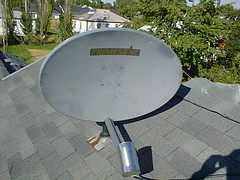DIY Friday: Convert Your Primestar Dish to 802.11
Friday, August 4th, 2006 What do you do if you need to get WiFi access in a relatively remote location — say, a distant outbuilding? Waiting for WiMAX might mean waiting a long time in rural areas. Why not just grab an old Primestar dish, a tin can, and some coaxial cable, and rig up your own WiFi antenna?
What do you do if you need to get WiFi access in a relatively remote location — say, a distant outbuilding? Waiting for WiMAX might mean waiting a long time in rural areas. Why not just grab an old Primestar dish, a tin can, and some coaxial cable, and rig up your own WiFi antenna?
A student at Walla Walla College explains:
It is easy to make a surplus Primestar dish into a highly directional antenna for the very popular IEEE 802.11 wireless networking. The resulting antenna has about 22 db of gain, and is fed with 50 ohm coaxial cable. Usually LMR400 or 9913 low loss cable is used if the source is more than a few feet from the antenna. The range using two of these antennas with a line of sight path is around 10 miles at full bandwidth. I must stress the line of sight part though. Leaves really attenuate the signal.
The "things you need" can be found easily by any aspiring MacGyver:
1. A Primestar dish. (You may use any old dish, but if it is bigger than the Primestar the gain will be higher, and it may not be within the Federal Communications Commission rules for use within the United States. In fact I have come to find out that there seem to be several different dishes that Primestar used, and I am only sure that the one I used, pictured above, used with the ordinary Wavelan or Airport transceiver card is within the effective radiated power limits given by the FCC.)
2. A juice can (about 4 inches in diameter and at least 8 inches long).
3. A chassis mount N connector.
4. You will also need a "pigtail" connector which has the proprietary Lucent connector (for the PCMCIA card) on one end and an N connector on the other. The pigtail can be obtained from a number of online stores for $35 to $40.
Once assembled, you’ll want to brace the highly directional antenna securely against the wind.

